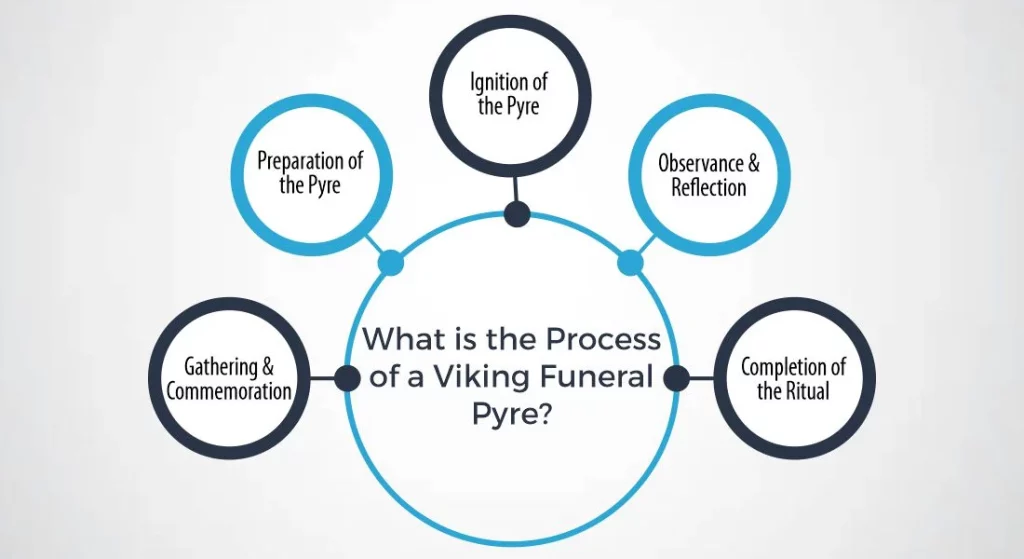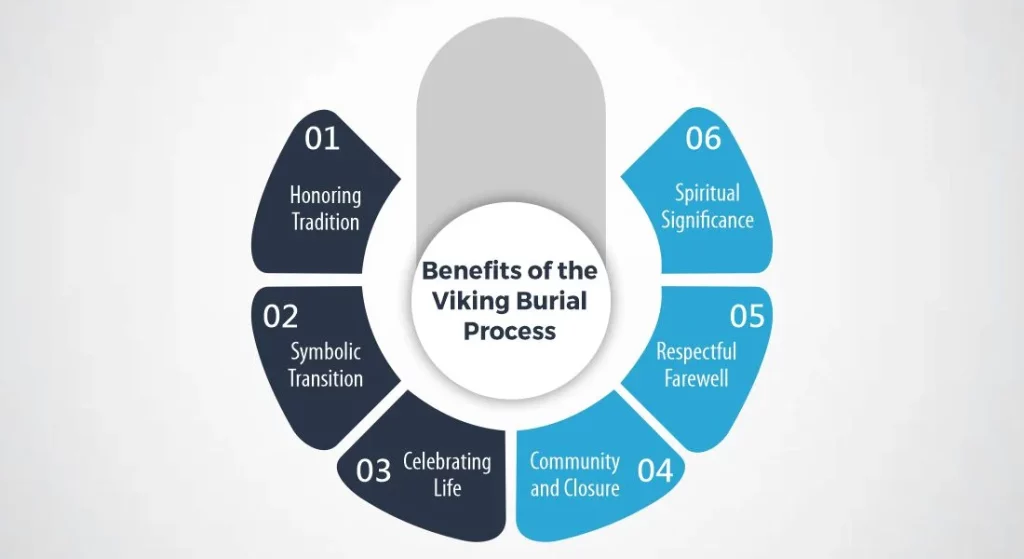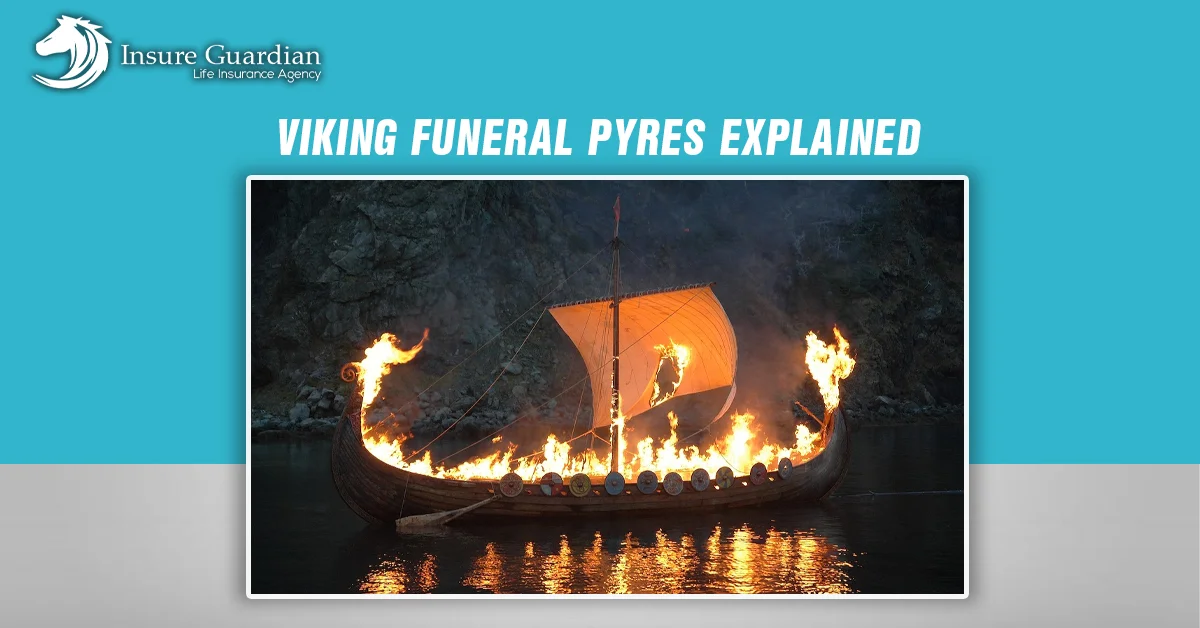Travel back to a long-ago time when brave warriors and ancient customs shaped the world; the Viking era. Imagine a special goodbye, where a big fire sent loved ones on their next journey. Vikings, famous for their adventures and stories, said farewell in a way that was both amazing and meaningful.
Thinking about a Viking funeral might bring to mind big fires and epic scenes from movies. But there’s more to it than just that; it’s a special way of saying goodbye that’s been around for a very long time.
Let’s explore together the secrets of Viking funerals, the way they built the special fires, how the goodbye viking burial ceremony happened, and what rules we need to follow today. We’ll uncover the heart of this ancient tradition that shows respect for those who have passed, connecting their stories to the past and beyond.
What is a Viking Funeral Pyre?
A Viking funeral pyre was a ceremonial ritual practiced by the Vikings, the seafaring peoples of Scandinavia during the medieval period. It was a unique way to honor the deceased by cremating their remains in a specially constructed pyre or funeral fire. This tradition involved placing the body or cremated remains of the departed on a structure made of wood or other combustible materials, often accompanied by personal belongings or symbolic items.
The pyre was set ablaze in a solemn ceremony, and the resulting fire was believed to release the spirit of the departed, allowing them to journey into the afterlife. The Viking funeral pyre symbolized a transition and was seen as a way to honor the individual’s life and ensure a respectful passage into the next realm.
While popular culture often portrays Viking funerals as grand and dramatic, the actual practices might have varied among different Viking communities and individuals. Nonetheless, the essence of the ritual emphasized reverence for the departed and their journey beyond this world.
How to Build a Viking Funeral Pyre?
Constructing a Viking funeral pyre involved careful planning and adherence to certain traditions. While historical specifics might vary, the general process encompassed several key steps:
Selecting Materials
Choose wood suitable for burning, often preferring resinous types like pine or fir due to their flammability. The quantity and quality of the wood were crucial for a sustained and significant fire.
Preparing the Site
Find an open area away from flammable structures or vegetation. Clear the ground and create a safe space for the pyre.
Building the Pyre
Start with a sturdy base of logs or larger wooden pieces. Gradually stack smaller wood pieces and kindling in a teepee-like structure, allowing air to flow and the fire to catch easily.
Adding Symbolism
Place the body or cremated remains of the departed atop the pyre. Sometimes, personal belongings or symbolic items were included to accompany the departed on their journey.
Igniting the Pyre
Conduct a solemn viking burial ceremony to light the pyre, often performed by a designated individual or spiritual leader. This marked the beginning of the ritualistic burning.
The aim was to create a pyre that would burn steadily and sufficiently to honor the departed’s transition into the afterlife, accompanied by respectful ceremonies and farewells from loved ones. The “Viking send off” is a popular term for burial rituals in Norse culture. It often involves placing the deceased on a boat set aflame and pushed out to sea, symbolizing a journey to the afterlife. While historically embellished, it remains a potent symbol of Viking valor and adventure.

What is the Process of a Viking Funeral Pyre?
The Viking send off a Viking funeral pyre was a ceremonial and solemn affair, designed to honor the departed individual and guide their spirit into the afterlife. It typically involved several distinct steps:
1- Gathering and Commemoration
Family, friends, and community members would gather to pay their respects and honor the departed. Eulogies, songs, or prayers might be offered to celebrate the life of the individual.
2- Preparation of the Pyre
The viking funeral pyre , constructed from wood or other combustible materials, would have been meticulously arranged in a specific structure. The body or cremated remains of the deceased, along with symbolic items or personal belongings, were placed atop the pyre.
3- Ignition of the Pyre
A designated person or spiritual leader would ceremoniously ignite the pyre. This act marked the beginning of the funeral ritual, symbolizing the release of the departed’s spirit and their journey into the afterlife.
4- Observance and Reflection
As the flames engulfed the pyre, attendees would reflect on the life and legacy of the departed. Farewells, prayers, or quiet moments of contemplation were common during this phase.
5- Completion of the Ritual
The viking funeral pyre would burn until the remains were fully consumed by the fire. The ashes left behind were considered a testament to the individual’s transition and were often gathered respectfully for further rites or burial.

Difference between Norse funeral pyre and Viking funeral pyre:
| Aspect | Norse Funeral Pyre | Viking Funeral Pyre |
| Origin and Culture | Rooted in Norse mythology and cultural practices. | Associated with the Norse people, often referred to as Vikings, but also practiced by other Scandinavian cultures. |
| Participants | Conducted by family and community members. | Often involved the deceased’s family, but also included fellow warriors, chieftains, and sometimes slaves or thralls. |
| Purpose | Symbolized the journey of the soul to the afterlife. | Emphasized the honor and valor of the deceased, particularly warriors, and their passage to Valhalla, the hall of slain heroes. |
| Ritual Elements | – Place the deceased on a wooden pyre. | – Deceased placed on a ship or boat, sometimes along with possessions, weapons, or even sacrificed animals. |
| – Offerings placed alongside the deceased. | – The ship is set aflame by flaming arrows or other means. | |
| – Prayers and invocations to guide the soul. | – Emphasized spectacle and grandeur, with feasting, drinking, and sometimes human sacrifice. | |
| Symbolism | Signified the transition from life to the afterlife. | Celebrated the heroic deeds and warrior spirit of the deceased, showcasing their valor and readiness for battle in the afterlife. |
| Community Involvement | A solemn and communal event, often held outdoors. | Could be a grand and public affair, with a larger community or tribe participating in the festivities. |
| Legacy and Influence | Enduring legacy in Norse cultural practices and beliefs. | Often depicted in Norse sagas, influencing popular perception of Viking culture. |
| Continues to inspire reverence for the interconnectedness of life and death in Norse mythology. | Symbolizes the romanticized image of Viking warriors as fearless and adventurous figures. |
Benefits of the Viking Burial Process
The Viking burial process, particularly the use of funeral pyres, offered several significant benefits, both culturally and symbolically:
Honoring Tradition
Viking funeral pyres were deeply rooted in Norse traditions, reflecting the cultural and spiritual beliefs of the community. Following these rituals allowed for the continuation of ancient practices, preserving cultural heritage and maintaining a connection to ancestral customs.
Symbolic Transition
The pyre symbolized a profound transition from the earthly realm to the afterlife. The act of cremation and the release of the spirit through fire signified the departure of the individual, ensuring a passage to the next phase of existence.
Celebrating Life
Viking burial ceremony celebrated the life and achievements of the departed. Through communal gatherings, songs, eulogies, and symbolic offerings placed on the pyre, the person’s legacy and contributions were honored and remembered.
Community and Closure
These rituals brought together communities in shared mourning and remembrance. The collective participation in the funeral process provided a sense of closure for the bereaved, fostering support and solidarity among family and friends.
Respectful Farewell
The ceremonial nature of the viking funeral pyre allowed for a dignified and respectful farewell to the departed. It provided a way to bid farewell with reverence, ensuring the individual was sent off with honor and respect.
Spiritual Significance
Believing in the release of the spirit through fire, Viking funeral pyres held spiritual significance, reinforcing the belief in an afterlife and facilitating the journey of the departed to the realms beyond.
Is a Viking Funeral Pyre Legal?
Are you thinking about is a Viking funeral legal? The legality of conducting a traditional Viking funeral pyre in modern times varies significantly based on location, local regulations, and cultural considerations.
In many places, open-air funeral pyres are not legally permitted due to various reasons such as environmental concerns, fire safety regulations, or cultural restrictions. These regulations are often in place to protect public safety, prevent wildfires, and ensure environmental conservation.
It’s crucial to research and understand is a Viking funeral legal in your area regarding funeral practices to ensure compliance while honoring the Viking funeral traditions and wishes of the departed and their family. Seeking guidance from relevant authorities or funeral service providers can offer clarity on permissible practices within legal boundaries.
Honoring The Passing Of Loved Ones
Honoring the passing of loved ones is a deeply personal and emotional journey, and the rituals involved, including Viking funeral pyres, play a crucial role in this process.
Celebrating Their Life
Honoring a loved one’s passing involves celebrating their life and the impact they had. Through rituals like Viking funeral pyres, families and communities come together to reminisce, share stories, and pay tribute to the deceased’s accomplishments and cherished memories.
Emotional Closure
Rituals provide a structured way to process grief and find closure. Participating in ceremonies, whether through a pyre or other Viking funeral traditions, allows individuals to express their emotions, bid farewell, and begin their healing journey.
Continuation of Legacy
Honoring loved ones ensures their legacy lives on. By following cultural or family-specific Viking funeral traditions , such as a Viking funeral pyre, it perpetuates the customs and values cherished by the departed, passing them on to future generations.
Support and Unity
Commemorative rituals bring communities together, offering support and solace to those mourning the loss. Sharing the experience with others who knew and cared for the departed provides a sense of unity and comfort during a challenging time.
Spiritual and Emotional Connection
Rituals often hold spiritual significance and help individuals connect with their faith or beliefs regarding the afterlife. This connection can offer reassurance and a sense of peace to those mourning the loss of a loved one.
Honoring the passing of loved ones, whether through ancient rituals like Viking funeral pyres or other customs, allows individuals to pay homage to their significance in our lives, fostering a sense of reverence and remembrance.
Conclusion
The tradition of Viking funeral pyres, while rooted in ancient practices, continues to captivate the imagination today. While legal constraints may limit the exact replication of historical pyres, modern adaptations retain the essence of the ritual, allowing families to honor their loved ones in a respectful and meaningful manner.
FAQs
1- Were Viking funeral pyres only reserved for warriors?
Contrary to popular belief, Viking funeral pyres were not exclusively reserved for warriors. While some notable figures might have received elaborate pyres, these ceremonies were conducted for individuals from various walks of life.
2- Are Viking funeral pyres legal in any modern-day contexts?
Legal acceptance of open-air funeral pyres varies widely across different regions and countries. It’s essential to consult local authorities and adhere to legal requirements when considering such ceremonies.
3- Can modern cremation services incorporate Viking funeral elements?
Yes, many cremation services offer ceremonies that incorporate elements reminiscent of Viking funeral rituals, providing a respectful and legally compliant alternative.

Meet Haider, our expert Life Insurance Content Writer and Editor. With a passion for clarity, he simplify the complex world of life insurance, delivering informative, polished content tailored to our clients’ needs.







